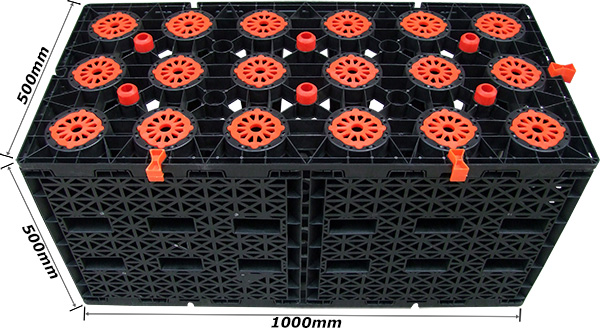M2018 Rainwater Modules: High-Strength (Up to 60 Tons/m2) Solutions for Urban Sustainability
2023-07-18
Abstract: As an environmental engineering expert, I am thrilled to present the M2018 Rainwater Modules, a remarkable innovation in stormwater management. These high-strength modular units can withstand pressures of up to 60 tons/m2, offering robust solutions for urban sustainability. Read on to explore how these modular water storage tanks can revolutionize stormwater management, flood control, and water conservation.
In the arena of sustainable urban planning,
the deployment of reliable Stormwater Modules has become increasingly vital.
Among these solutions, M2018
Rainwater Modules, also known as Modular Storm Water Tanks, offer
unparalleled structural integrity and efficiency. With an impressive pressure
tolerance of up to 60 tons/m2, these units make perfect Modular Stormwater
Detention systems, even for the most demanding scenarios like fire lanes or
parking lots.

One of the exceptional features of M2018
Rainwater Modules is their modular design, making them highly adaptable for
various uses. Whether it's a modular stormwater tank for a residential project
or a more comprehensive modular water storage tank system for an industrial
site, these modules can be efficiently tailored to the specific needs of the
project.
Underground Stormwater Detention Tanks are
a common sight in urban landscapes today. But the M2018 stands apart with its
high-strength design, making it an excellent option for Soakaway Crates and
Infiltration Tanks. The capacity to bear high loads without compromising on
performance ensures the safety and longevity of these Stormwater Detention
Tanks.
To understand the transformative potential
of M2018 Rainwater Modules, consider their application as Modular Plastic
Geocellular Systems. In these configurations, the modules can function as
efficient Rainwater Retention Crates, actively participating in a sustainable
Rainwater Harvesting Module system. As Modular Rainwater Storage Tanks, they capture,
store, and repurpose rainwater, reducing the burden on conventional water
resources and promoting sustainability.
An integral component of modern stormwater
management is the Stormwater Attenuation Tank, designed to control the release
of stormwater into the drainage system. M2018 Rainwater Modules excel in this
role, with their robust structure forming dependable Geocellular Storage
Crates.
As Modular Geocellular Units, these modules
offer an efficient way to manage and store stormwater, while their resilience
ensures they can serve as reliable Stormwater Drainage Tanks. Moreover, their
modular design makes them suitable for use as Geocellular Infiltration Tank
Units, where they contribute to efficient stormwater infiltration and
groundwater recharge.

One of the most innovative applications of
M2018 Rainwater Modules is their role in the Geocellular Water Box Management
System. This system offers a holistic solution for rainwater management,
combining aspects of storage, infiltration, and release. In this configuration,
the modules form a robust Rainwater Drainage System, effectively mitigating the
risks associated with urban stormwater.
Finally, the M2018 Rainwater Modules can be
integrated as Stormwater Attenuation Cells in larger stormwater management
systems. Their high-strength design, flexibility, and efficient water handling
make them a favored choice among environmental engineers and urban planners.
In conclusion, the M2018 Rainwater Modules
offer robust, flexible, and high-performing solutions for stormwater management
and water conservation. As we face the challenges of urbanization and climate
change, these high-strength modules pave the way for sustainable urban futures.

PrécédentThe Power of Hexagonal Design: Understanding HOENSOEY Cells
ProchaineHOENSOEY Cells, The Innovative Stormwater Management Modules
Message






